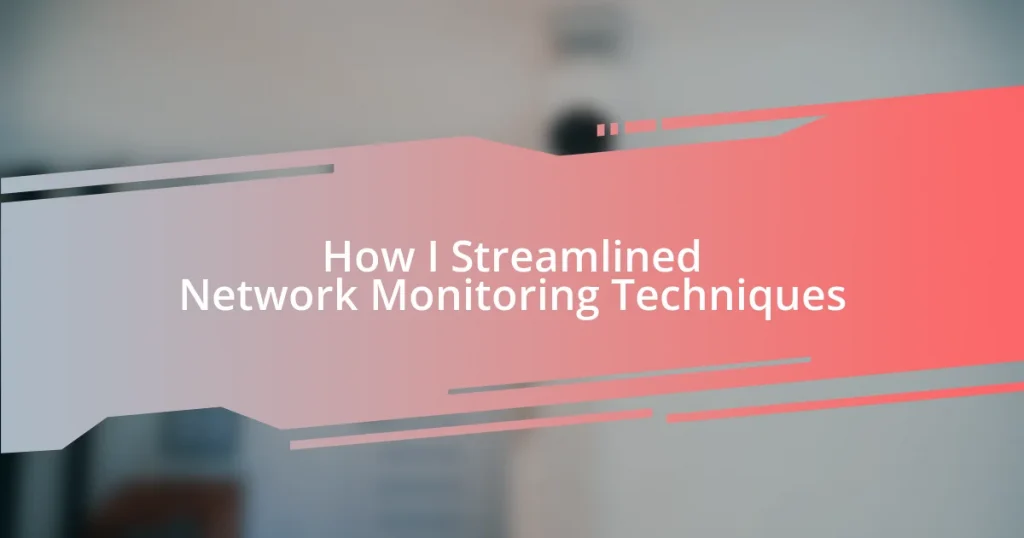Key takeaways:
- Real-time monitoring is crucial for detecting network issues proactively, akin to a doctor checking vital signs to prevent health crises.
- Focusing on key metrics like bandwidth utilization and latency is essential for effective monitoring, avoiding information overload while enabling strategic responses.
- Continuous improvement through feedback and adaptation to new technologies enhances network management, transforming operational challenges into opportunities for growth.
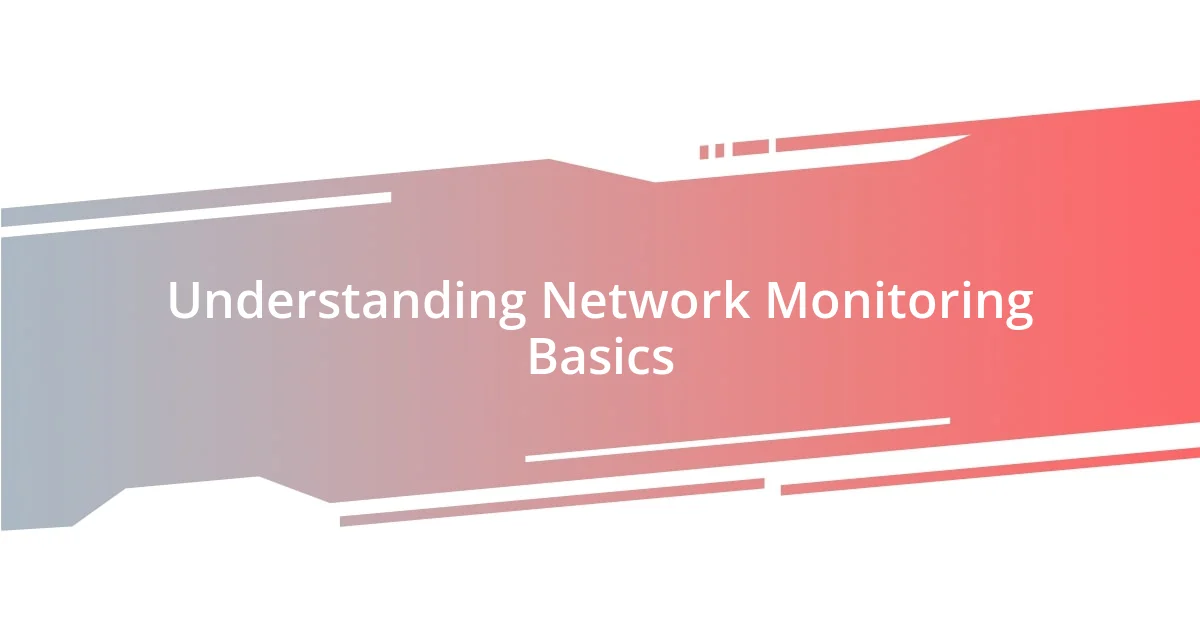
Understanding Network Monitoring Basics
Network monitoring is an essential practice for maintaining the health of any digital environment. From my experience, the first step is understanding what network monitoring entails: it involves the continuous assessment of a network to detect issues, manage traffic, and ensure optimal performance. Think of it like a doctor regularly checking vital signs to catch potential health problems before they escalate.
One moment that really marked my understanding of network monitoring was during a server outage at my previous job. The panic that ensued made it crystal clear how crucial real-time insights are. Without those metrics, it’s like navigating in the dark—confusing and stressful. It’s important to ask ourselves: how can we respond effectively if we don’t even know what’s happening in our network?
The basics of network monitoring often include tracking bandwidth usage, identifying bottlenecks, and ensuring security compliance. Each of these elements plays a role in keeping operations smooth and efficient. I remember when I first implemented a monitoring tool—it was eye-opening to see the traffic patterns in real time. Suddenly, I had the power to proactively address issues before they could impact users. Understanding these fundamental techniques really gives you a sense of control over your network environment.
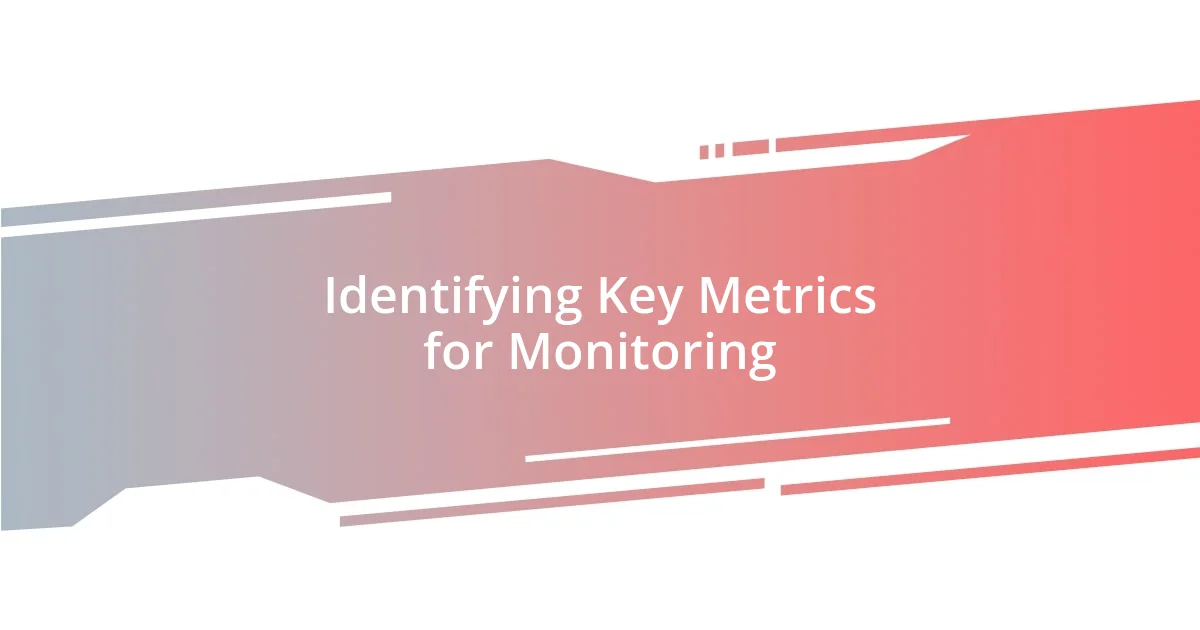
Identifying Key Metrics for Monitoring
Identifying key metrics for monitoring can feel overwhelming, but I’ve found it’s all about honing in on what truly matters. During my early days in network management, I got caught up in tracking every possible data point, only to realize that I was drowning in information rather than gaining clarity. It was like trying to find meaning in a sea of numbers, and ultimately, I learned that focusing on targeted metrics is what makes all the difference.
To streamline your monitoring process, here are the key metrics I recommend prioritizing:
- Bandwidth Utilization: Understand how much bandwidth is being used versus how much is available. I vividly recall a time when a sudden spike in usage exposed a hidden application draining our resources.
- Latency Measurements: Keep an eye on the time it takes for data to travel across the network. This became a crucial factor during a project launch where any delay was unacceptable.
- Error Rates: Track the frequency of errors that occur. I once uncovered persistent errors that went unaddressed; resolving them significantly improved user experience.
- Device Uptime: Monitoring how long your devices stay operational can save you from unexpected downtime during critical times.
- Traffic Patterns: Analyzing trends over time helps anticipate future needs. That insight once allowed me to implement changes before peak usage hit, which was a game-changer.
By concentrating on these metrics, I’m able to maintain a clear perspective of what’s happening in my network. It feels empowering to be able to address issues before they escalate, allowing me to act from a place of knowledge rather than reaction.
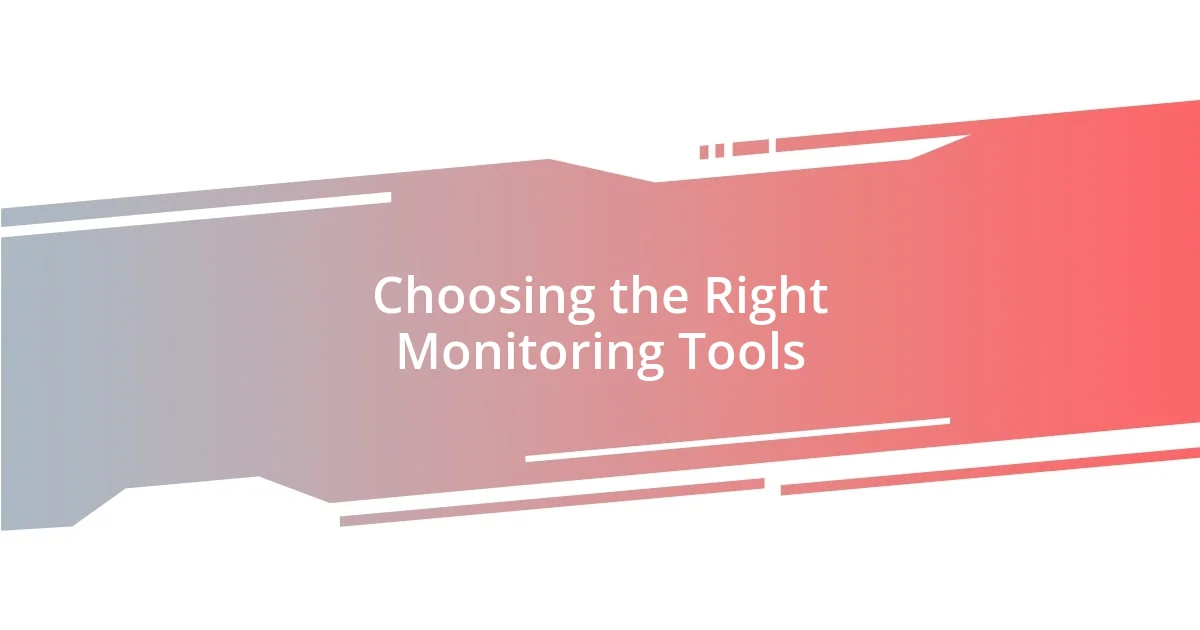
Choosing the Right Monitoring Tools
Choosing the right monitoring tools is vital for achieving effective network oversight. From my experience, the selection process can be daunting due to the plethora of options available. I vividly remember the first time I faced this decision; it felt like choosing a car without knowing the features I’d truly need. I ultimately focused on tools that offered scalability and integrated easily with our existing systems, which turned out to be a game changer for our monitoring strategy.
It’s essential to consider what your specific requirements are before diving in. A tool that works for one organization might not suit another due to differences in infrastructure and goals. I once settled on a comprehensive monitoring suite, thinking it would cover all bases, but soon realized that its complexity overwhelmed my team. As a result, we had to shift to a more intuitive solution that aligned better with our workflow, highlighting the importance of assessing usability alongside functionality.
Lastly, while price is an important factor, I learned that the cheapest option isn’t always the best. When we opted for a low-cost tool, we quickly encountered limitations that stifled our ability to respond to incidents effectively. Instead, I recommend evaluating tools based on total value, which includes customer support and community resources. A tool’s backing can often make all the difference, especially when you encounter challenges down the line.
| Tool Type | Key Features |
|---|---|
| Open Source | Customization, Community Support |
| Commercial | Robust Support, Regular Updates |
| Cloud-Based | Scalability, Accessible from Anywhere |
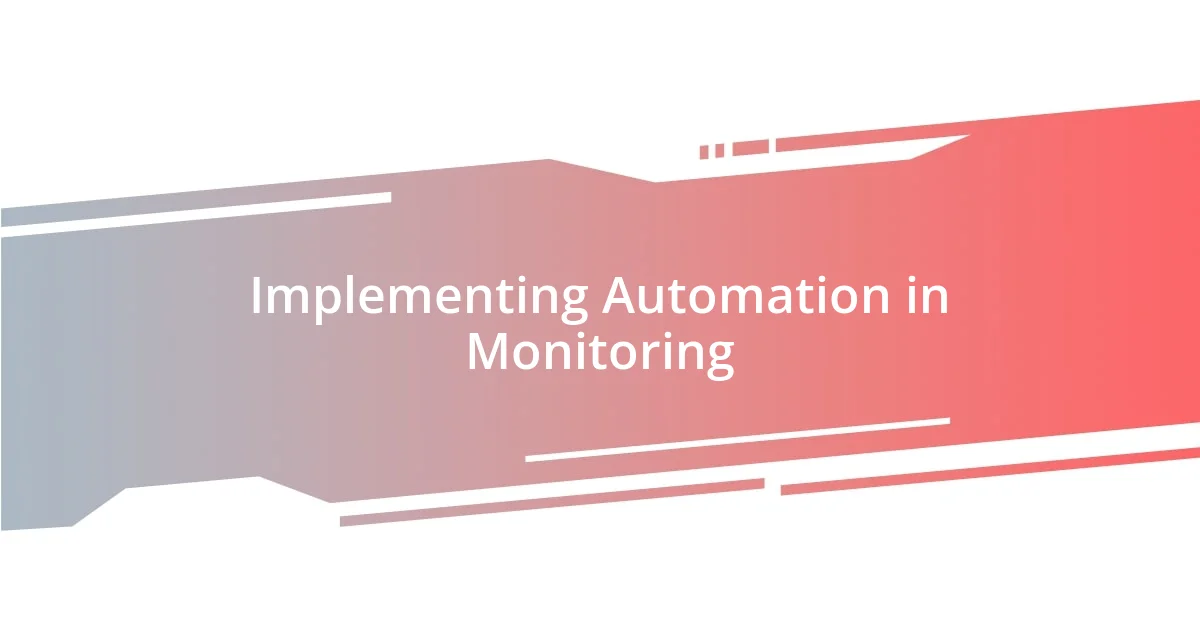
Implementing Automation in Monitoring
Implementing automation in monitoring has truly revolutionized my approach to network management. I remember a time when I spent countless hours sifting through alerts, drowning in data. By integrating automation, I now have systems that automatically flag anomalies and highlight essential metrics. It’s like having an extra set of eyes that never blinks—a real game changer.
One powerful tool I adopted was an automated alert system that tailored notifications based on specific thresholds. I found myself less stressed as I no longer had to be glued to screens, manually checking everything. Instead, I could focus on strategic planning and proactive measures. Have you ever experienced that relief when technology takes over the grunt work, allowing you to focus on creative problem-solving? I certainly did, and it’s liberating.
It’s important to note that while automation is fantastic, it doesn’t mean we should set and forget. I’ve learned that continuous tuning of automated processes is essential. I once had a situation where automated alerts became so streamlined that I stopped paying attention, leading me to miss a critical event. This experience taught me the value of striking the right balance between automation and oversight. Regularly reviewing settings keeps you in the loop and ensures you maintain control over your network environment. Wouldn’t you agree that staying engaged is key in leveraging technology effectively?
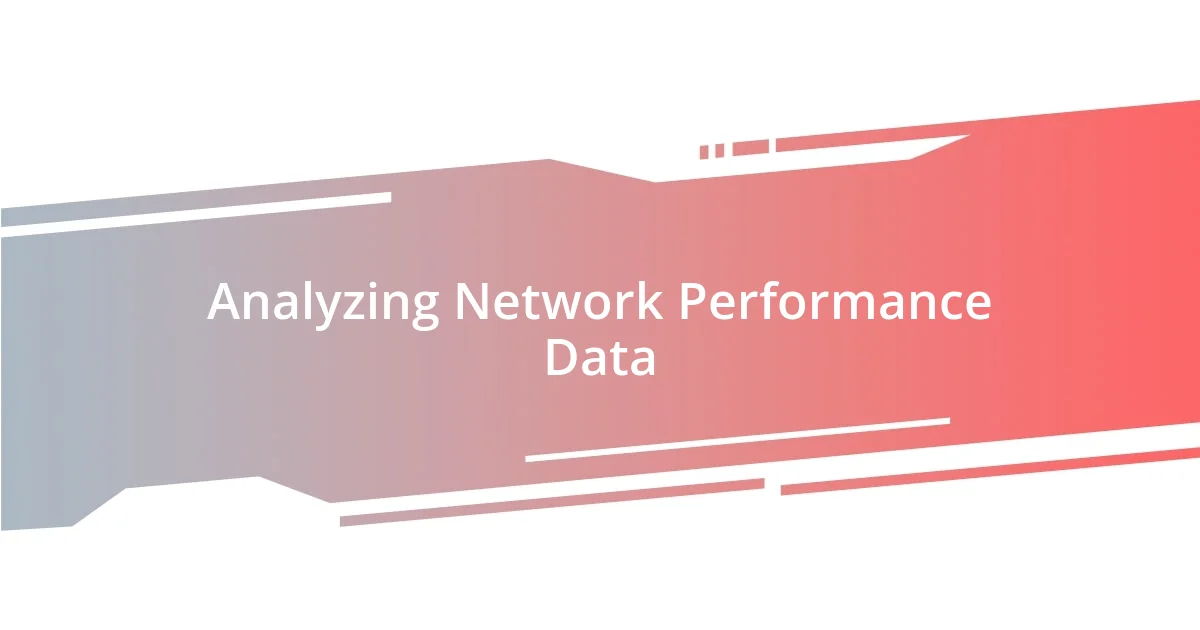
Analyzing Network Performance Data
Analyzing network performance data is where the magic truly happens. I often find myself pouring over metrics to understand how our network behaves under different loads. It’s fascinating to see how small changes in traffic can lead to noticeable spikes in latency. Have you ever traced the roots of a slow connection back to an unexpected source? It’s essential to get to the heart of the matter by examining patterns in data rather than just looking for quick fixes.
In my experience, visualizing data through graphs and charts has made a significant difference. When I began using dashboard tools that presented real-time insights, I could easily spot trends and anomalies. I remember a moment when I noticed an unexplained dip in bandwidth. Digging deeper, I discovered unauthorized devices were hogging resources. That experience drove home the point for me: comprehensive analysis empowers swift action.
Moreover, I’ve learned that data should tell a story. It’s not enough to collect information; we have to interpret it meaningfully. I recall an afternoon spent dissecting performance logs—at first, it seemed tedious, but as I connected the dots, I uncovered recurring issues that had gone unnoticed. This revelation enabled us to implement lasting solutions, ultimately improving our operational efficiency. Isn’t it satisfying to transform raw data into actionable insights? Each analysis session feels like peeling back layers to reveal what truly drives our network’s performance.
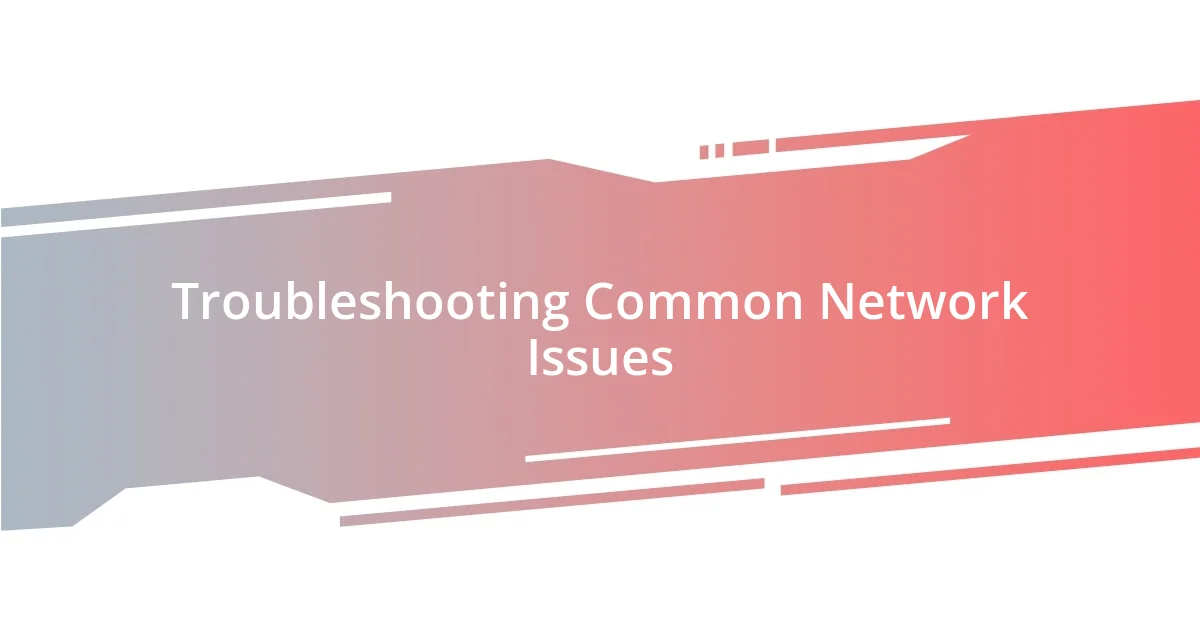
Troubleshooting Common Network Issues
Troubleshooting common network issues can sometimes feel like trying to find a needle in a haystack. I recall a particularly frustrating day when users were complaining of intermittent connectivity. After some digging, I realized an overlooked switch was overloaded due to misconfigurations. This experience reinforced the importance of keeping a clear overview of every component in my network. Isn’t it incredible how the smallest detail can lead to widespread disruption?
Another recurring issue I’ve encountered is related to IP conflicts, which can cause devices to drop off the network unexpectedly. I once spent hours trying to locate a rogue device amidst a pile of reports. Finally, I realized that a static IP had been mistakenly assigned to two different devices. This taught me a vital lesson about the importance of maintaining updated records of IP assignments. Have you ever had a similar experience where the solution was simple and yet so elusive?
Lastly, I find that network latency often poses its own set of challenges. There was a time when we launched a new application, and users reported frustrating delays. Through systematic testing, I uncovered that a particular router was the bottleneck. Once replaced, performance improved dramatically. It highlighted for me the importance of regularly reviewing and refreshing hardware. After all, how can we expect our networks to perform optimally if we’re not proactive in addressing aging equipment?
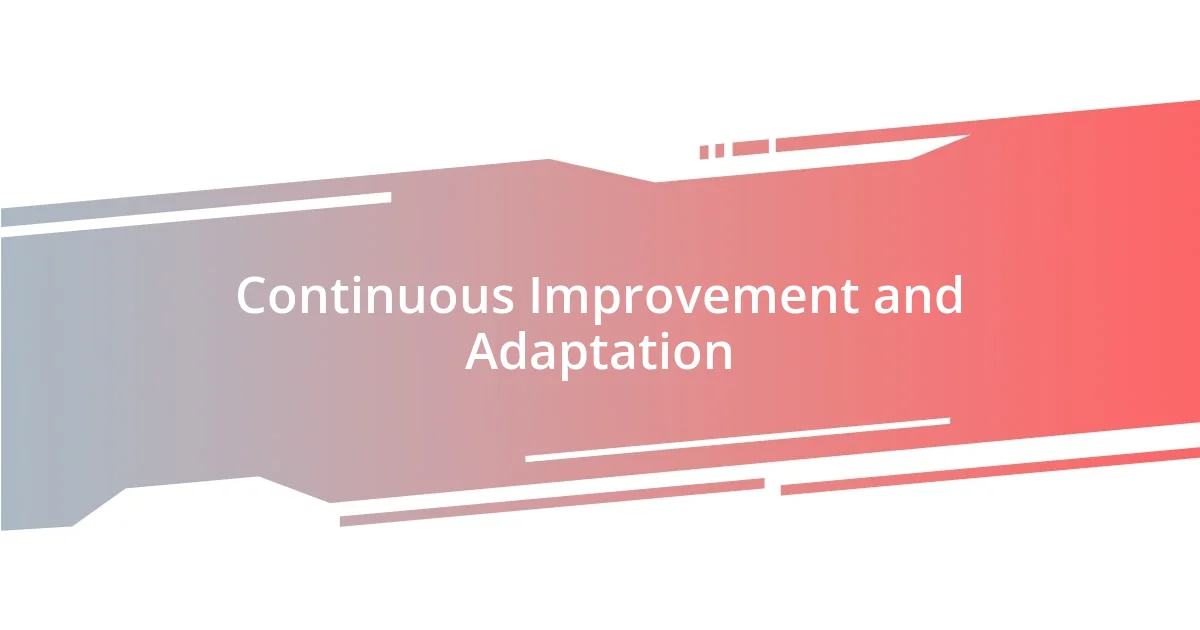
Continuous Improvement and Adaptation
Continuous improvement and adaptation are pivotal in refining our network monitoring techniques. I vividly recall when our team decided to implement regular feedback sessions after each project sprint. It was eye-opening to hear different perspectives about what worked and what didn’t. Have you noticed how even small adjustments can lead to substantial advancements? I was surprised by how just a minor tweak in our monitoring tools improved response times and user satisfaction.
Additionally, I’ve found that staying informed about the latest technologies is essential. For instance, I remember attending a networking conference and learning about a new machine learning model for anomaly detection. Integrating this model into our monitoring process elevated our ability to anticipate issues before they arose. There’s an undeniable thrill in discovering solutions that can elevate your performance. Have you ever experienced the excitement that comes from adapting to innovations that reshape your approach?
Lastly, I prioritize a culture of experimentation within my team. For example, we recently piloted a new approach to monitoring traffic patterns based on user behavior instead of traditional metrics. The results were astonishing! Not only did we gain deeper insights, but team morale also soared from our collaborative efforts. Isn’t it empowering to see how a willingness to adapt leads to richer outcomes? Continuous improvement isn’t just a process; it’s a mindset that can transform our network operations into a dynamic force for success.










